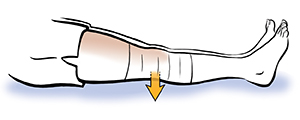After Knee Replacement: At-Home Exercise Program
Apply the skills you learned in the hospital or rehab center to your exercise program at home. Use a walker, cane, or crutches to help you move safely. By sticking with your exercise program, you’ll walk more easily and return to an active life sooner. Contact your healthcare provider or physical therapist if you have pain while exercising.
Maintaining your exercise program
Make exercise part of your daily routine. Lack of exercise can cause joint stiffness and decreased range of motion. But with continued exercise, you may even gain more strength and range of motion than you had before surgery. Keep meeting with your physical therapist as directed. They may add riding a stationary bike or other new exercises to your program.
Below is a list of exercises your physical therapist may suggest.
Quadriceps sets
Lying on your back, tighten your thigh muscles. Try to straighten your knee. Hold for 5 to 10 seconds. Gradually build up your time.

Straight leg raises
Tighten your thigh and straighten your knee as with the quadriceps set above. Lift your leg several inches (above your buttocks) off the bed and hold for 5 to 10 seconds. Gradually increase your time and number of repetitions.

Sitting knee exercises
Start with 10 repetitions. Build up to 25 repetitions per session. Do 2 sessions each day.
-
Sit in a chair with both feet flat on the floor.
-
Slowly straighten your operated or affected leg as much as you can. Hold for 5 seconds.
-
Slowly bend your leg under the chair, bringing it back as far as you can. Hold for 10 to 20 seconds. Return your leg to the starting point.
